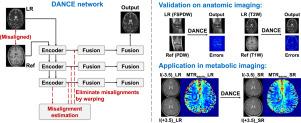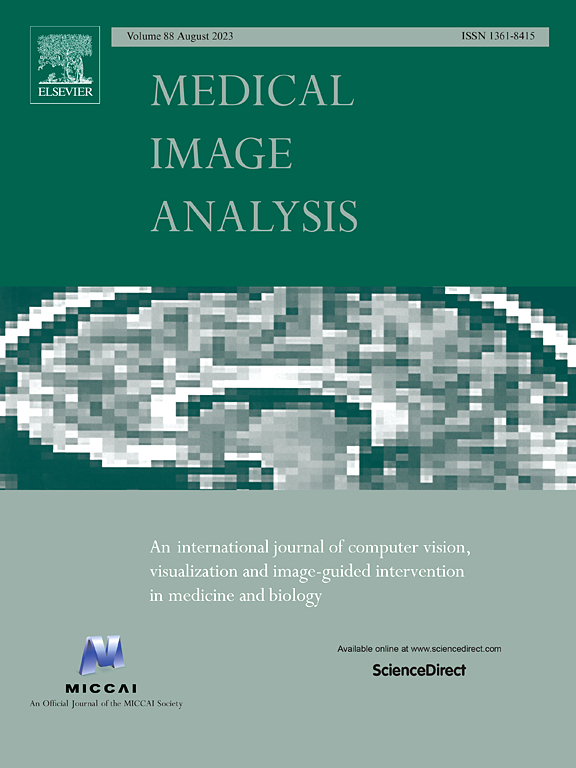Multi-contrast image super-resolution with deformable attention and neighborhood-based feature aggregation (DANCE): Applications in anatomic and metabolic MRI
IF 11.8
1区 医学
Q1 COMPUTER SCIENCE, ARTIFICIAL INTELLIGENCE
引用次数: 0
Abstract
Multi-contrast magnetic resonance imaging (MRI) reflects information about human tissues from different perspectives and has wide clinical applications. By utilizing the auxiliary information from reference images (Refs) in the easy-to-obtain modality, multi-contrast MRI super-resolution (SR) methods can synthesize high-resolution (HR) images from their low-resolution (LR) counterparts in the hard-to-obtain modality. In this study, we systematically discussed the potential impacts caused by cross-modal misalignments between LRs and Refs and, based on this discussion, proposed a novel deep-learning-based method with Deformable Attention and Neighborhood-based feature aggregation to be Computationally Efficient (DANCE) and insensitive to misalignments. Our method has been evaluated in two public MRI datasets, i.e., IXI and FastMRI, and an in-house MR metabolic imaging dataset with amide proton transfer weighted (APTW) images. Experimental results reveal that our method consistently outperforms baselines in various scenarios, with significant superiority observed in the misaligned group of IXI dataset and the prospective study of the clinical dataset. The robustness study proves that our method is insensitive to misalignments, maintaining an average PSNR of 30.67 dB when faced with a maximum range of ±9°and ±9 pixels of rotation and translation on Refs. Given our method’s desirable comprehensive performance, good robustness, and moderate computational complexity, it possesses substantial potential for clinical applications.

利用可变形注意力和基于邻域的特征聚合(DANCE)实现多对比图像超分辨率:在解剖和代谢磁共振成像中的应用。
多对比度磁共振成像(MRI)从不同角度反映人体组织信息,具有广泛的临床应用价值。多对比磁共振成像超分辨率(SR)方法通过利用易获取模式中参考图像(Refs)的辅助信息,可从难获取模式中的低分辨率(LR)对应图像合成高分辨率(HR)图像。在这项研究中,我们系统地讨论了低分辨率图像和参考图像之间的跨模态错位可能造成的影响,并在此基础上提出了一种基于深度学习的新型方法,该方法具有可变形注意力和基于邻域的特征聚合,计算效率高(DANCE)且对错位不敏感。我们的方法在两个公共磁共振成像数据集(即 IXI 和 FastMRI)和一个内部磁共振代谢成像数据集(含酰胺质子转移加权(APTW)图像)中进行了评估。实验结果表明,在各种情况下,我们的方法始终优于基线方法,在 IXI 数据集的错位组和临床数据集的前瞻性研究中观察到了明显的优越性。鲁棒性研究证明,我们的方法对错位不敏感,在面对参考文献上最大范围为 ±9° 和 ±9 像素的旋转和平移时,平均 PSNR 保持在 30.67 dB。鉴于我们的方法具有理想的综合性能、良好的鲁棒性和适中的计算复杂度,它在临床应用中具有巨大的潜力。
本文章由计算机程序翻译,如有差异,请以英文原文为准。
求助全文
约1分钟内获得全文
求助全文
来源期刊

Medical image analysis
工程技术-工程:生物医学
CiteScore
22.10
自引率
6.40%
发文量
309
审稿时长
6.6 months
期刊介绍:
Medical Image Analysis serves as a platform for sharing new research findings in the realm of medical and biological image analysis, with a focus on applications of computer vision, virtual reality, and robotics to biomedical imaging challenges. The journal prioritizes the publication of high-quality, original papers contributing to the fundamental science of processing, analyzing, and utilizing medical and biological images. It welcomes approaches utilizing biomedical image datasets across all spatial scales, from molecular/cellular imaging to tissue/organ imaging.
 求助内容:
求助内容: 应助结果提醒方式:
应助结果提醒方式:


